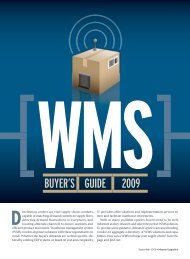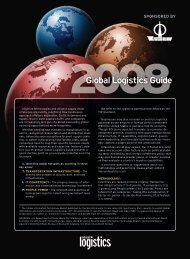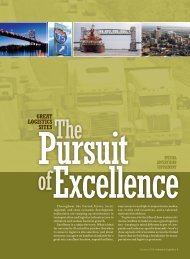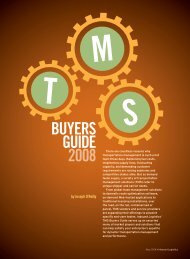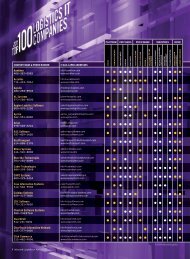Best Practices Playbook - Inbound Logistics
Best Practices Playbook - Inbound Logistics
Best Practices Playbook - Inbound Logistics
- No tags were found...
You also want an ePaper? Increase the reach of your titles
YUMPU automatically turns print PDFs into web optimized ePapers that Google loves.
DRAFT PICKSPlanning for the Turnover:Strategiesfor ChoosingTransportationPartnersEvaluate your transportation requirements to determine1 the following: your type of freight by mode; lead time withcarriers; territories and lanes being served; frequency ofvolume in lanes; and unique requirements, such as palletexchange or blanket wrap.Implement a core carrier program – concentrate service2 to a select number of capable, high-performance carriers.Guarantee them a portion of your projected volume inreturn for better rates and service quality commitment.Create an RFP that clearly states your requirements for3 bidding; for timing and response; and for the media tobe used in carrier presentations. Also include schedulerequirements, such as a time frame for solicitation and submission;carrier evaluation and selection; purchasing andcontracting procedures; and rate and terms negotiation.Select a group of carriers that most likely will meet your4 requirements. Access to a large group allows you to selectcarriers based on a set of filters.Standardize contract terms and requirements. Create a5 template to harmonize rate structures and accessorialcharges, and insist that carriers define rates and theircontext in common terms.Clearly state your performance expectations. Determine6 which attributes you will measure, such as on-timeperformance, acceptance rate, and equipment type andavailability.Outline your business process and communication7 methods. State whether you will use a software systemor manual processes; how you will perform tendering,acceptance, and timing; appointment scheduling; shipmentstatus and the required event reporting and timing; andsettlement.SPOTTING anAll-Star:Questions for prospectivecarriers★★ Does the carrier have sufficientcapacity to serve all yourtransportation needs?★★★★Is the carrier financially stable – noton the brink of insolvency – andwilling to reinvest in its businessand maintain the type of qualityequipment necessary to service yourneeds?Can the carrier supply referencesfrom businesses that are similar toyours?★★ Has the carrier made significanttechnology investments?★★★★★★★★Can the carrier provide real-timevisibility of shipment status andadvance warning of service failuresthat will allow you to respond to yourcustomers?Does the carrier have a centralizedcustomer service center withthe tools necessary to quicklycommunicate your needs and/orproblems to the proper location?If you require EDI for load tendering,shipment status, delivery notification,billing and/or remittance, can thecarrier support those needs?Does the carrier have quality billingprocesses?★★ Can the carrier provide you with thedocumentation you require?★★★★★★Can the carrier respond quickly toany special requests that you mayhave?If your equipment requirementschange, will the carrier be able tohandle it?If your customers need specialhandling, can the carrieraccommodate them, too?<strong>Inbound</strong> <strong>Logistics</strong> • July 2009



